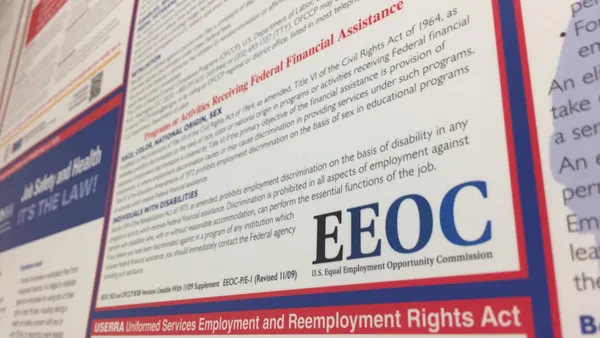Dive Brief:
- The U.S. Department of Labor announced Monday a rule withdrawing and re-proposing a portion of a Trump administration 2020 final rule regarding tip pool regulations under the Fair Labor Standards Act.
- The proposal aims to address situations in which an employee performs both tipped and untipped work, also known as a "dual job." Under the proposed rule, employers would only be able to take a tip credit if their tipped employees performed work that is part of the employees' tipped occupation.
- Such work would include work that produces tips as well as work that "directly supports" tip-producing work, DOL said, provided the supporting work is not performed for a "substantial amount of time." Work that supports tip-producing work is performed for a substantial amount of time if it either exceeds, in the aggregate, 20% of the employee's hours during the workweek, or is performed for a continuous period of time exceeding 30 minutes.
Dive Insight:
Tip regulations have proven to be one of the most active areas for regulatory activity at the federal level, and DOL's announcement this week is the latest in a series of changes and delays.
When the Trump administration DOL proposed last year an update to the agency's interpretation of the FLSA's tip regs, it addressed the "dual job" issue by stating that employers could take a tip credit for the time a tipped employee spent performing related, non-tipped duties, as long as those duties were performed contemporaneously with, or for a reasonable time immediately before or after, tipped duties.
The 2020 final rule also implemented guidance from a 2018 opinion letter, in which DOL stated that employers could take a tip credit for an employee's work if the employee's tasks were on the O*NET task list for that tipped job. The O*NET list could be used "as a source of guidance for determining when a tipped employee's non-tipped duties are related to his or her tipped occupation," DOL said in the 2020 rule.
While the Biden administration subsequently allowed certain components of the 2020 final rule to take effect April 30, it delayed other parts — including the "dual job" component — from taking effect until Dec. 31.
In order to address the "dual job" issue, DOL's latest proposal marks something of a return to the so-called "80/20" guidance that characterized the agency's approach to tip credits from the late 1980s until 2009, when the administration of former President George W. Bush issued an opinion letter rescinding the 80/20 approach. The Obama administration withdrew the letter and revised the then-existing 80/20 guidance, but the Trump administration re-issued the letter in 2018, effectively withdrawing the 80/20 approach.
As DOL noted in the proposal to be published June 23, employers and their representatives have criticized the 80/20 guidance for being challenging to administer. For example, the agency cited a comment on a 2019 proposed rulemaking by law firm Littler Mendelson stating that the 80/20 approach "did not include a 'comprehensive list of related duties or even a way to determine which duties were related,'" among other issues.
Citing district court rulings, however, DOL said it "believes that 20 percent of an employee's workweek is an appropriate tolerance for non-tipped work that is part of the tipped employee's occupation. The Department seeks comments, however, on whether a different portion of the employee's workweek would be appropriate or if another metric would be more appropriate."
DOL's proposal also defines "substantial amount of time" as "any continuous period of time that exceeds 30 minutes," which is meant to address concerns that the 80/20 guidance did not adequately address scenarios in which employees perform non-tipped, directly supporting work for extended periods of time.
"Particularly because the proposed guidance provides examples illustrating the type of work that is part of the tipped occupation, including work that is tip-producing and work that directly supports the tip-producing work, employers should be able to proactively identify work that counts toward the tolerance and assign work to tipped employees accordingly, to avoid going over this tolerance," DOL said. "Similarly, a continuous, uninterrupted block of 30 minutes or more is a significant amount of time, and does not require the minute-by-minute micromanaging with which the 2020 Tip final rule expressed concern."
Stakeholders will have the opportunity to submit public comments on or before 60 days after the proposal is published in the Federal Register.











